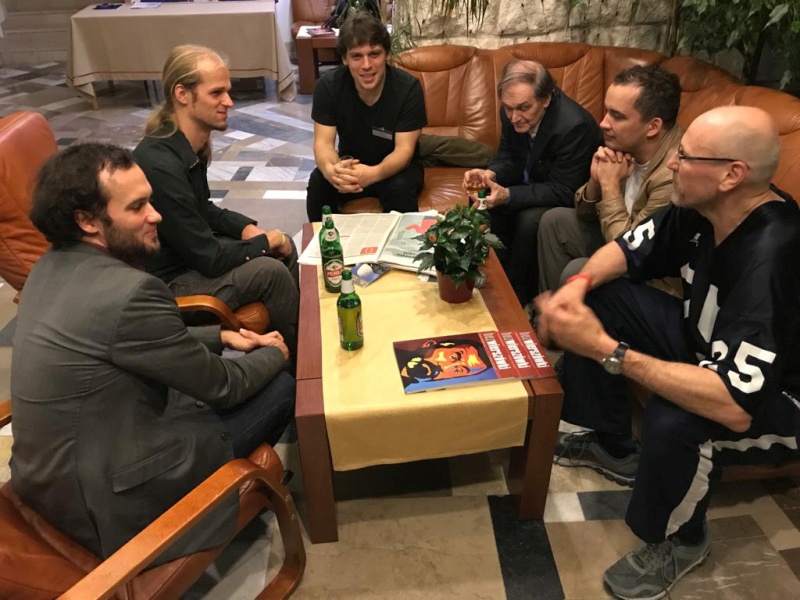
A group of friends discussing over dinner the classical and quantum black holes [Warszawa, 14ty września, 2019] from the left: Jerzy Lewandowski, Roger Penrose, Yongge Ma, Ted Newman, Carlo Rovelli, Francesca Vidotto
Sir Roger Penrose, Honorary Member of the Polish Society on Relativity is among the 2020 Nobel Laureates in Physics. His distinguished achievement is the black hole theory. The concept of a black hole can already be found in the work of Laplace and was developed thanks to Einstein’s theory and the solutions of Schwarzschild and Kerr (to which also Robinson and Trautman contributed). However, it was Sir Roger who proved the spacetime singularity theorem and formulated the cosmic censorship conjecture that imply that black hole is the final stage for a large class of gravitational collapse processes, in fact inevitable if a trapped surface has formed in space-time. Penrose also discovered, in a purely theoretical way, the process of extracting energy from a black hole at the expense of its momentum. Today’s observations confirm the role that the Penrose process plays in black hole astrophysics. PoToR members continue to research various new issues in black hole theory.
Sir Roger also made outstanding contributions to other areas of the theory of gravity and other fields of science. His works on the asymptotic properties of space-time are fundamental for the theory of gravitational radiation. Penrose’s theory of twistors led to the development of new branches of differential geometry and algebraic topology. Penrose’s tailing found its realization in nature in the form of quasicrystals, a special form of a solid state in which atoms arrange themselves in an apparently regular, but not repeating structure. Penrose’s Triangle Impossible was the inspiration for Escher’s paintings.
The last time we hosted Sir Roger Penrose in Poland as a guest of the conference on the occasion of Jerzy Lewandowski’s 60th birthday on September 16-20, 2019. Sir Roger gave a lecture on the theory of twistors:
https://www.youtube.com/embed/hr_5QzbUqBw
Roger: Congratulations!

Form the left: Tomasz Trzesniewski, Daniel Nemeth, Michal Artymowski, Roger Penrose, Jan Ostrowski, Jerzy Lewandowski
Another part of the Nobel Prize in Physics 2020 is shared by prof. Andrea Ghez (University of California, Los Angeles) and prof. Reinhard Genzel (Max Plank Instiute for Extraterrestrial Physics, Garching) “for the discovery of a supermassive compact object at the centre of our galaxy”. They are leaders of two research teams, who have been monitoring the motions of stars orbiting the Galactic centre for nearly three decades. Genzel’s group used telescopes in Chile operated by the European Southern Observatory (ESO), while Ghez and her colleagues used the Keck Observatory in Hawaii. Their works have been essential for proving that the supermassive black hole resides in the center of our Galaxy, as predicted by the theory of gravity. Penrose’s discovery of the singularity theorem showed that black holes are a robust consequence of general relativity, forming naturally in very overdense regions. The central few parsecs of the Milky Way harbours a rich cluster of stars and hot gas. These have been used to trace the gravitational potential of the Galactic centre defined by the compact radio source Sagittarius A* (Sgr A*), at a distance of 25,000 light years. If the mass concentration at the very centre of the Galaxy is made of a single supermassive black hole, the velocities of stars there should be growing for progressively smaller radii, as for planets around the Sun. Such Keplerian orbits should not arise if the mass is due to a spatially distributed cluster of stellar-mass objects. Thanks to the work of Ghez and Genzel’s groups, the orbits of the brightest stars closest to the middle of the Milky Way have been mapped with increasing precision. Their pioneering work has given us the most convincing evidence yet of a supermassive black hole at the centre of the Milky Way.
Prof. Andrea Ghez became 4th woman winning Nobel Prize in Physics, after Maria Curie-Skłodowska (1903), Maria Goeppert-Mayer (1963), Donna Strickland (2018).


